LP78
| General Landscape Description: Irrigated pasture on a flat plain. Original vegetation included River Red Gum (Eucalyptus camaldulensis) and Black Box (Eucalyptus largiflorens). |
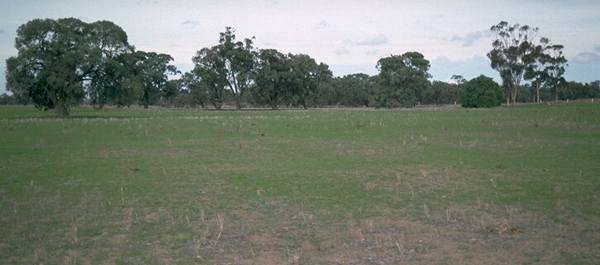 LP78 Landscape |
Soil Profile Morphology
Surface Soil
| A1 | 0-10 cm | Dark greyish brown (10YR4/2); medium clay; self-mulching surface condition with surface flake; strong fine polyhedral structure (rough faced peds); very firm consistence dry; pH 7.1; clear and smooth change to: | 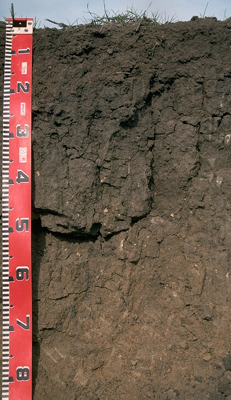 LP78 Profile |
| Subsoil | |||
| B21 | 10-55 cm | Grey (10YR5/1); medium heavy clay; strong coarse angular blocky structure (smooth faced peds); at the base of this layer there are some carbonate nodules; pH 7.9; clear and wavy change to: | |
| B22 | 55-90 cm | Pale brown (10YR6/3); light medium clay; strong coarse blocky structure (smooth faced peds); strong consistence moist; contains a few (5%) carbonate nodules (5-10 mm in size); pH 8.8; gradual change to: | |
| B23 | 90+ cm | Brownish yellow (10YR6/6); medium clay; strong fine polyhedral structure (with smooth faced peds); firm consistence moist; contains a few (10%) dark flecks; pH 8.7. | |
Key Profile Features
- Self mulching with surface flake on the surface.
- Accumulation of carbonate nodules in the subsoil.
Key Profile Characteristics
pH | Salinity Rating | |||
Surface (A1 horizon) | slightly alkaline | low | non-sodic | none (strong) |
Subsoil (B21 horizon) | slightly alkaline | very low | non-sodic | none (strong) |
Deeper subsoil (at 90+ cm) | strongly alkaline | medium | strongly sodic | strong |
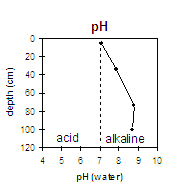 | 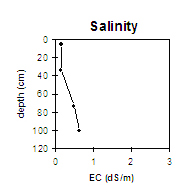 | 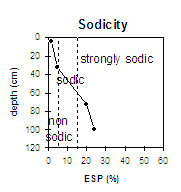 |  |
The surface and upper subsoil is slightly alkaline becoming strongly alkaline at 75 cm. | The salinity rating is low in the surface soil becoming moderate at about 75 cm. | The surface is non-sodic. The subsoil becomes strongly sodic at about 60 cm. | The clay content is very high throughout the profile. |
Management Considerations:
- Whole Profile
- A very positive feature of this profile is that it has a high inherent fertility in the surface and a very high inherent fertility in the subsoil. This is very beneficial to plant growth.
- The surface is self-mulching which provides a good seed bed that is friable and easily worked. The organic carbon and nitrogen levels are moderate which is also very good for plant development (a bulked sample from across the paddock would be required to accurately assess this).
- Is surface flake due to high clay content??
- The surface soil is non-sodic with no dispersion. The presence of strong dispersion after remoulding indicates that structural degradation (e.g. surface sealing, increased cloddiness) may occur if the soil is cultivated or overstocked in a moist to wet condition. Also, raindrop action on bare surface soil may also promote dispersion and exacerbate the hardsetting condition. Surface cover should be maintained to protect against raindrop damage. The use of gypsum may assist in ameliorating the surface soil and decreasing the hardsetting condition. Interestingly, a plough line was observed within this horizon.
- High levels of exchangeable calcium and magnesium throughout the subsoil is beneficial for promoting good soil structure which benefits root development.
- The subsoil becomes strongly alkaline at 75 cm and this suggests that some nutrients (e.g. manganese, zinc, iron, copper) may be poorly available to plants. Nutrient deficiencies can be assessed by plant tissue analysis.
- The coarsely structured deeper subsoil (60 cm) is strongly sodic with a low exchangeable calcium to magnesium ratio (0.7). Strong dispersion occurs as a result restricting root and water movement. Deep ripping into the subsoil would help to break up the physical structural problems and the application of gypsum would help to neutralise the chemical sodic problems. This expensive option would firstly depend on expected crop yield and also on adequate rainfall, to wash the gypsum down the deep rips into the subsoil. Gypsum can also be added to the surface without deep ripping, but it would require more time to wash the gypsum down to the subsoil and less of it would probably make it.
- The salinity rating becomes moderate at about 75 cm. These levels of soluble salts are likely to restrict the growth of deep rooted salt sensitive plant species (e.g. faba beans, linseed, chickpeas and lupins).
Surface (A) Horizon
Subsoil (B) Horizons
Profile described by Mark Imhof, Sonia Thompson and Paul Rampant, May 1995.


